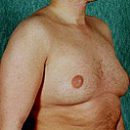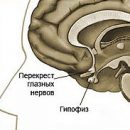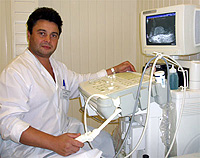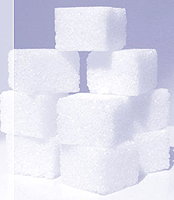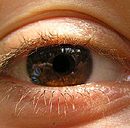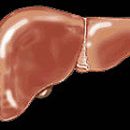Eutheroid nodal goiter is a collective concept in which such thyroid diseases are combined as colloidate goiter, follicular adenoma, nodal version of the hypertrophic form of autoimmune thyroiditis, cyst of the thyroid gland. Treatment of diseases is carried out with the help of medication and surgical operations.
Content
The concept of the eutheroid nodal zob
The nodal euticide goiter is a collective, used before setting the clinical diagnosis The concept that is combined by the thyroid diseases such as colloidate goiter, follicular adenoma, a nodal version of the hypertrophic form of autoimmune thyroiditis, thyroid cyst.
 Allocation of concept «Nodular euticoid goble» It is due to the fact that the clinically listed diseases do not differ from each other and in most cases the final differential diagnosis between them turns out to be possible only on the basis of a thin game aspiration biopsy of the thyroid gland formation. When screening a healthy population using palpation, the nodal formations of the thyroid gland are found in 3-5%, and with autopsy of the tisside tissue, every 2 mm, they are detected in 50% of the surveys; less than 5% of clinically manifested themselves nodes are malignant. The colloid goiter, according to the development mechanism associated with the chronic deficit of an alimentary iodine, is formed mainly due to the excess accumulation of colloid in the follicle cavity and is more likely to be nodal than diffuse. Follicular adenoma - a benign tumor of the thyroid gland from a follicular epithelium. With the hypertrophic form of autoimmune thyroiditis as a result of the local hyperplasia of the thyroid gland, pseudo-nodes are often formed.
Allocation of concept «Nodular euticoid goble» It is due to the fact that the clinically listed diseases do not differ from each other and in most cases the final differential diagnosis between them turns out to be possible only on the basis of a thin game aspiration biopsy of the thyroid gland formation. When screening a healthy population using palpation, the nodal formations of the thyroid gland are found in 3-5%, and with autopsy of the tisside tissue, every 2 mm, they are detected in 50% of the surveys; less than 5% of clinically manifested themselves nodes are malignant. The colloid goiter, according to the development mechanism associated with the chronic deficit of an alimentary iodine, is formed mainly due to the excess accumulation of colloid in the follicle cavity and is more likely to be nodal than diffuse. Follicular adenoma - a benign tumor of the thyroid gland from a follicular epithelium. With the hypertrophic form of autoimmune thyroiditis as a result of the local hyperplasia of the thyroid gland, pseudo-nodes are often formed.
Thyroid cyst - Extensive, filled with cystic liquid Education in the tissue of the thyroid gland. The true cyst of the thyroid gland differs from the false presence of a felling of follicular epithelium. The cyst of the thyroid gland must be differentiated from the cystadenoma. In the latter case, we are talking about the formation of the breakdown cavity in the tumor of the thyroid gland. Thyroid cysts make up 3-5% of the nodal formations of the thyroid gland. Formed as a result of small hemorrhages, dystrophy of colloidal nodes, hyperplasia of single follicles.
Clinical picture of the disease
The presence of assembly formation in the thyroid gland, determined during palpation. With a hormonal study, eutheosis is detected. It should be noted that the diseases of the thyroid gland can develop on the background of both hypothyroidism and thyrotoxicosis. Uzi confirms and accurately characterizes the dimensions of the nodal education.
Diagnosis of the disease
Diagnostic search for ultrasound, primarily aimed at eliminating thyroid cancer.
Differential diagnosis of wethyoid goiter and, thus, the establishment of a clinical diagnosis on the basis of ultrasound is ignorant. Palpiored nodal formations, as well as a nodal goiter, exceeding the ultrasound data of 1 cm in diameter, are subject to a thin-game aspiration biopsy, if necessary, under the control of ultrasound. With thyroid scintigraphy, nodal formations can be characterized as cold, warm and hot. The cyst of the thyroid gland is defined as a node with a hyperheogenic rim and a practically an echogenic internal structure. With a thin-game aspiration biopsy, liquid is obtained.
Treatment options
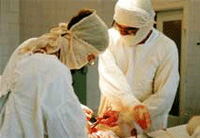 Nodal formations are less than 1 cm in diameter (random find with ultrasound) clinical values do not have. Dynamic control is needed with ultrasound (1 time in 6 months). In iodhyatic regions, the appointment of preventive doses of iodide potassium is shown.
Nodal formations are less than 1 cm in diameter (random find with ultrasound) clinical values do not have. Dynamic control is needed with ultrasound (1 time in 6 months). In iodhyatic regions, the appointment of preventive doses of iodide potassium is shown.
With the most clearly occurring colloid zob, not exceeding in diameter 3 cm, therapy L-thyroxin and potassium iodide is shown. Potassium iodide is prescribed in a prophylactic dose (for adults 200 μg / day). The purpose of the purpose of L-thyroxin is to suppress the level of thyrotropic hormone to the lower limit of the norm, which will reduce its trophic effect on tirocytes. Usually this suppression of the level of thyrotropic hormone can be achieved by the appointment of 75-100 μg of the drug.
In the absence of an effect from conservative therapy, T. E. With an increase in the size of the node in ultrasound control after 6 months, the operational treatment is shown to remove the affected share. It is also shown in the follicular adenome, which is cytologically, t. E. In the study of the material obtained with a thin game aspiration biopsy, it is difficult to distinguish from highly differentiated thyroid cancer. With a thyroid cyst, a thin-game aspiration biopsy is shown with the subsequent sclerosing of the cavity of the cyst ethanol. With repeated relapses, the size of cysts is more than 3 cm, the presence of a dense fibrous capsule shows resection of the thyroid row.

